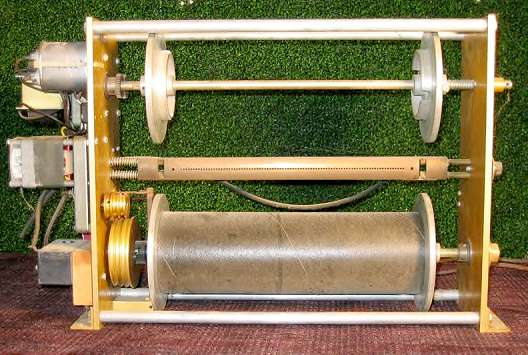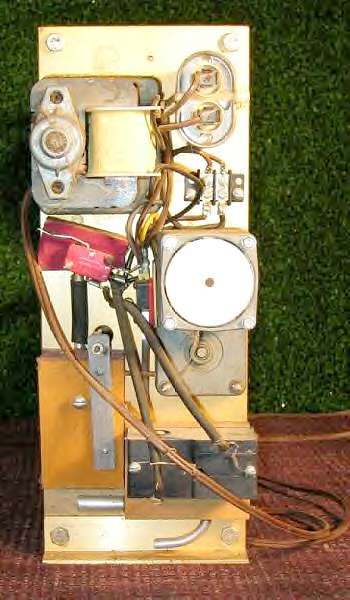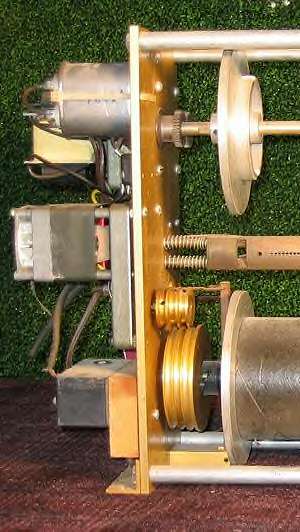| You Are Not Logged In | Login/Get New Account |
|
Please Log In. Accounts are free!
Logged In users are granted additional features including a more current version of the Archives and a simplified process for submitting articles. |
|
MMD
 Gallery
Gallery
 Tech
Tech
 SpoolF
SpoolF
 gloeggler
gloeggler
|
|
by Ed Gloeggler (040528 MMDigest)
Can anyone tell me about this 1970s or '80s O-Roll frame? It has gold anodized aluminium sides, two pneumatics and two 110 VAC Dayton (Grainger) gearmotors. The 20 RPM lower gearmotor drives the lower spool via 3-sheave aluminium pulleys and triple belts (made of rubber tubing). The spool frame is 5" deep, with side plates of 1/4" thick gold anodized aluminium. The frame connecting rods are drilled and tapped on each end for bolts that hold on the sides. Aluminium angles on the bottom are for mounting. A thumbscrew on the right side of the frame moves the tracker bar left and right. There is no automatic roll tracking of any kind, though the tracker bar can be removed by loosening the adjusting screw. The top spool is easily removed by moving it to the right to disengage the left end. There are ball bearings pressed into the side frames. The top (rewind) gearmotor is labeled Dayton Model 2Z811B, 120 RPM, 115V, 0.48AMP. There is a terminal block by the motors for the AC supply to the unit. The brown wires are simply stubs of zip cord that powered this thing. The 0.4 ufd capacitor mounted at the top is connected to the lower (play) gearmotor. Its label says Dayton #3M153, 20 RPM, 115V, 60 Hz, 0.3 AMP. It also says Motor Red # QGM-5023-2. The white disk on the rear of the motor is an integral fan.
The lower motor has three leads attached to it. Luckily a wiring diagram is stamped on the bottom that shows a motor with a forward and reverse winding using a SPDT selector switch for forward or reverse. No speed control circuit is shown in the diagram. As this is the play motor, I don't see how they controlled the speed of the thing. The gearmotor drives the lower spool via aluminium pulleys and three belts (made of rubber tubing) which are missing in the photo. A little adjustable friction belt rubs against the bottom roll shaft to slow it during rewind. The two little unit valves at the bottom of the frame are plastic castings screwed on a wooden manifold that supplies suction. The valve on the right in the photo is mounted upside-down. Just below the top motor is a small pneumatic that operates a red microswitch. The bottom pneumatic (activated by the rewind or far right tracker bar hole through one of the plastic valve blocks) disengages the lower spool clutch. Now it gets a bit confusing. When power is applied to the unit, the lower spool begins to turn, for play. If the top pneumatic is activated alone, the miscroswitch reverses the lower spool, making it run backwards. If both pneumatics are activated together, the bottom spool motor turns off, the bottom spool clutch disengages and the top motor turns on, rewinding the roll. Who made it? I know the belts were prone to breaking. I'd also appreciate opinions of the design. Ed Gloeggler
28 May 2004 |
|
|
|
|
|
|
|
|
|
CONTACT FORM: Click HERE to write to the editor, or to post a message about Mechanical Musical Instruments to the MMD Unless otherwise noted, all opinions are those of the individual authors and may not represent those of the editors. Compilation copyright 1995-2025 by Jody Kravitz. Please read our Republication Policy before copying information from or creating links to this web site. Click HERE to contact the webmaster regarding problems with the website. |
|
|
||||||
|


